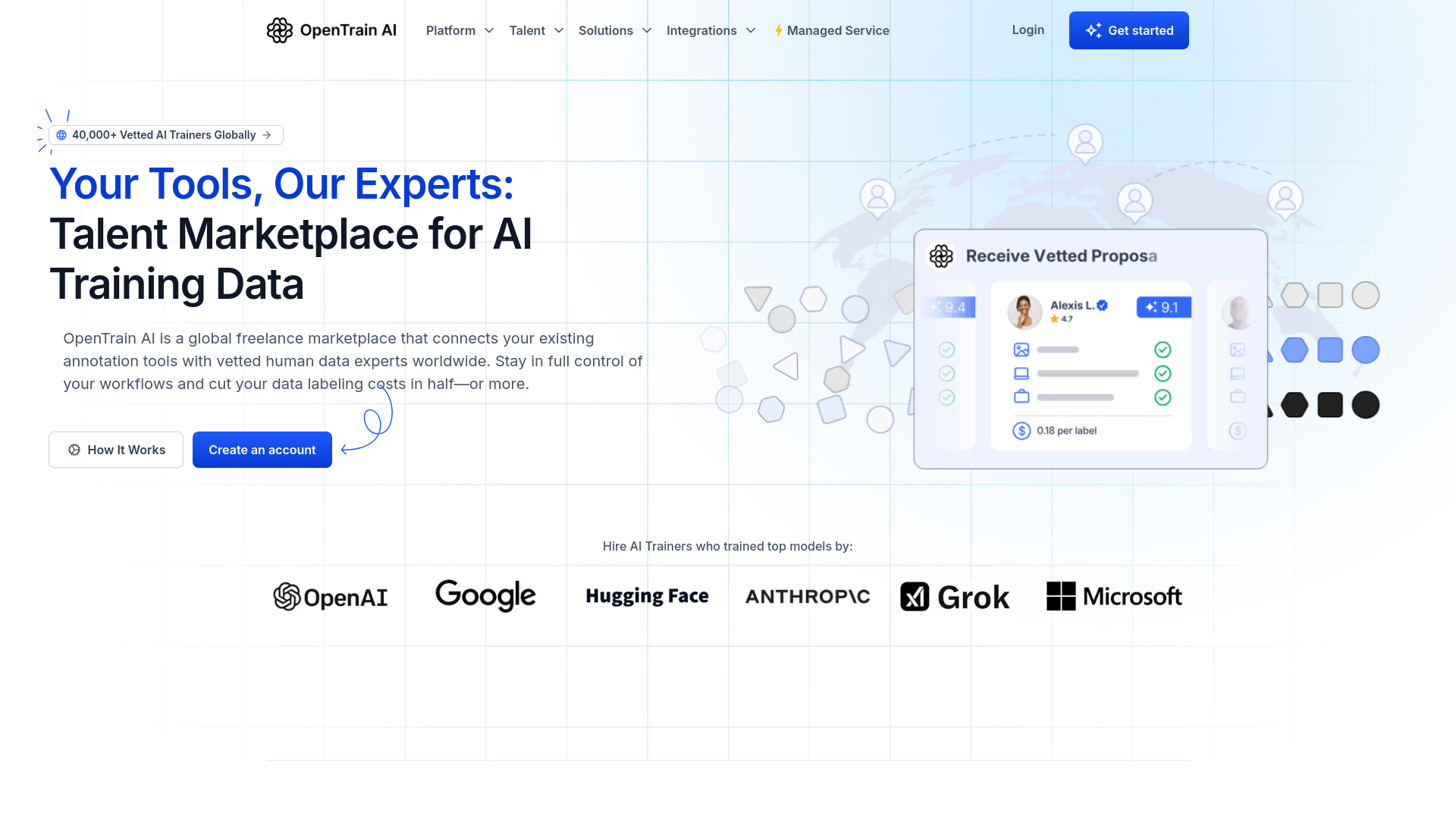- Home
- AI Recruiting
- OpenTrain AI

OpenTrain AI
Open Website-
Tool Introduction:Hire vetted data labelers worldwide; integrate any tool, pay securely.
-
Inclusion Date:Oct 28, 2025
-
Social Media & Email:
Tool Information
What is OpenTrain AI
OpenTrain AI is a global freelance marketplace that connects your existing data annotation tools with vetted human data experts. It enables teams to directly hire specialized labelers and QA reviewers for any AI training need—computer vision, NLP, speech, or structured data—so you reduce costs, maintain control, and accelerate high-quality dataset creation. With integration into any labeling software, secure worldwide payments, and an optional fully managed service, OpenTrain AI streamlines human-in-the-loop data labeling from sourcing to delivery.
OpenTrain AI Key Features
- Vetted global experts: Access a screened, domain-ready workforce for computer vision, NLP, audio, and structured data labeling.
- Bring-your-own tool integration: Connect any data labeling software to coordinate tasks, guidelines, and QC within your current stack.
- Direct hiring and control: Handpick annotators and reviewers, set workflows, and retain ownership of processes and outputs.
- Quality assurance at scale: Multi-pass review, consensus checks, gold data, and feedback loops to improve label accuracy.
- Flexible engagement models: On-demand contractors or a fully managed service for end-to-end project delivery.
- Secure global payments: Centralized, compliant payouts to international experts with clear tracking and invoicing.
- Cost-efficient operations: Reduce overhead versus traditional vendors while scaling up or down as demand changes.
- Specialized expertise: Support for edge cases, custom ontologies, domain glossaries, and complex annotation schemas.
- Transparent performance: Visibility into productivity, quality metrics, and throughput for continuous optimization.
Who Should Use OpenTrain AI
OpenTrain AI suits ML teams, data operations leaders, product managers, startups, and enterprises that need scalable, high-quality AI training data without losing workflow control. it's also ideal for research labs, consultancies, and organizations with existing annotation tools seeking a reliable human-in-the-loop workforce or a turnkey managed service.
How to Use OpenTrain AI
- Sign up and outline your project goals, data types, taxonomy, and quality targets.
- Choose the engagement model: hire freelance experts directly or opt for the fully managed service.
- Integrate your preferred labeling software, or confirm the stack used for managed projects.
- Publish role requirements and review vetted expert profiles, rates, and experience.
- Onboard selected experts with guidelines, examples, and edge-case definitions.
- Launch tasks, assign reviewers, and enable consensus or gold-standard checks.
- Monitor KPIs (accuracy, agreement, throughput) and provide iterative feedback.
- Approve milestones, handle secure global payments, and export labeled datasets.
- Refine taxonomy and instructions based on model performance and error analysis.
OpenTrain AI Industry Use Cases
Organizations use OpenTrain AI to power real-world AI initiatives, such as retail product recognition with bounding boxes and attributes, financial document classification and entity extraction, e-commerce search relevance and ranking judgments, call-center audio transcription and sentiment labeling, and LLM preference data or evaluation tasks. Teams leverage vetted experts to handle complex guidelines, improve label consistency, and accelerate dataset delivery.
OpenTrain AI Pricing
OpenTrain AI operates as a marketplace where you pay the experts you hire, typically by task, hour, or milestone. The fully managed service is usually priced via a custom scope of work based on data volume, complexity, and quality requirements. Secure global payments are supported. Specific rates vary by expertise, domain, and project demands.
OpenTrain AI Pros and Cons
Pros:
- Vetted global talent pool across CV, NLP, audio, and structured data.
- Integrates with any labeling software, preserving existing workflows.
- Direct hiring model offers control, transparency, and flexibility.
- Robust quality assurance with multi-pass review and gold data.
- Secure international payments and centralized vendor management.
- Option for fully managed, end-to-end project delivery.
Cons:
- Direct-hire model can require active project and quality management.
- Expert availability and rates may vary by niche domain and timezone.
- Tool integration and guideline design still demand internal effort.
- Data privacy and compliance need careful process controls on sensitive data.
OpenTrain AI FAQs
-
How does OpenTrain AI integrate with my existing labeling tool?
You can connect the platform to your preferred annotation software and manage tasks, guidelines, and QC within your current stack, while hiring and coordinating experts through OpenTrain AI.
-
Can I use a fully managed service instead of hiring freelancers?
Yes. OpenTrain AI offers an end-to-end managed service where in-house experts handle scoping, staffing, labeling, QA, and delivery.
-
How is label quality assured?
Projects commonly use consensus, gold standards, multi-pass review, and targeted feedback loops to maintain accuracy and consistency.
-
What kinds of projects are supported?
Computer vision, NLP, speech/audio, and structured data tasks, including classification, detection, segmentation, transcription, entity extraction, sentiment, and relevance judgments.
-
How are payments handled?
OpenTrain AI provides secure global payments with transparent invoicing and tracking for contractors and managed engagements.
-
Do I keep control over my labeling workflows?
Yes. With the marketplace model, you select experts, define guidelines, set QC policies, and retain control of processes and outputs.
